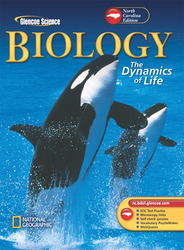1 A) a third phosphate group is bonded to an ATP molecule B) the third phosphate group breaks off from an ATP molecule C) ions are released into the bloodstream D) they break down sucrose to glucose and fructose 2 A) adenine and ribose B) ribose and a phosphate group C) two phosphate groups D) adenine and a phosphate group 3 A) a cell cannot create energy and must get it from elsewhere in the organism B) a cell can release only stored energy C) a cell can't always immediately use all the energy it gets D) an organism often has times when no energy is used 4 <a onClick="window.open('/olcweb/cgi/pluginpop.cgi?it=gif::::/sites/dl/free/0078675642/181859/Ch09_0_c.gif','popWin', 'width=NaN,height=NaN,resizable,scrollbars');" href="#"><img valign="absmiddle" height="16" width="16" border="0" src="/olcweb/styles/shared/linkicons/image.gif"> (14.0K)</a> A) destruction of CO<sub>2</sub> B) production of ADP C) production of NADP- D) sugar production 5 A) adenine B) two phosphate groups C) glucose D) ribose 6 <a onClick="window.open('/olcweb/cgi/pluginpop.cgi?it=gif::::/sites/dl/free/0078675642/181859/Ch09_0_a.gif','popWin', 'width=NaN,height=NaN,resizable,scrollbars');" href="#"><img valign="absmiddle" height="16" width="16" border="0" src="/olcweb/styles/shared/linkicons/image.gif"> (21.0K)</a> A) D B) C C) B D) A 7 <a onClick="window.open('/olcweb/cgi/pluginpop.cgi?it=gif::::/sites/dl/free/0078675642/181859/Ch09_0_d.gif','popWin', 'width=NaN,height=NaN,resizable,scrollbars');" href="#"><img valign="absmiddle" height="16" width="16" border="0" src="/olcweb/styles/shared/linkicons/image.gif"> (6.0K)</a> A) neither plants nor animals B) both plants and animals C) animals only D) plants only 8 A) light reactions produce NADP<sup>+</sup> from NADPH + H<sup>+</sup> B) Calvin cycle breaks down H<sub>2</sub>O C) light reactions release oxygen D) Calvin cycle yields CO<sub>2</sub> 9 A) carotenoids B) chlorophyll C) chloroplast D) stroma 10 <a onClick="window.open('/olcweb/cgi/pluginpop.cgi?it=gif::::/sites/dl/free/0078675642/181859/Ch09_0_b.gif','popWin', 'width=NaN,height=NaN,resizable,scrollbars');" href="#"><img valign="absmiddle" height="16" width="16" border="0" src="/olcweb/styles/shared/linkicons/image.gif"> (13.0K)</a> A) D B) C C) A D) B







